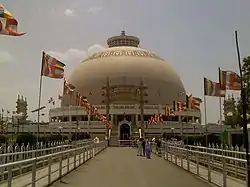 Deekshabhoomi monument, located in Nagpur, Maharashtra, where B. R. Ambedkar converted to Buddhism in 1956, is the largest stupa in Asia.[1] | |
| Total population | |
|---|---|
| Regions with significant populations | |
| Maharashtra | |
| Languages | |
| Marathi | |
| Religion | |
| Navayana Buddhism | |
| Related ethnic groups | |
| Marathi people |
Marathi Buddhists (Marāṭhī Bauddha) are Buddhists of Marathi ethnic and linguistic identity. The religious community resides in the Indian state of Maharashtra. They speak Marathi as their mother-tongue (first language). The Marathi Buddhist community is the largest Buddhist community in India. According to the 2011 Indian census, Marathi Buddhists constitute 5.81% of the population in Maharashtra, which is 77% of the total Buddhist population in India.[2]
History

Almost all Marathi Buddhists belong to the Navayana tradition, a 20th-century Buddhist revival movement in India that received its most substantial impetus from B. R. Ambedkar who called for the conversion to Buddhism by rejecting the caste-based society of Hinduism. This was though a socio-religious movement and the term "Navayana" was used to "simplify the present cultural complexities" in other sects of Buddhism. Overall this wasn't a completely new sect culturally and ritually as it borrows most of its traditions from Theravada sect of Sri Lanka. B. R. Ambedkar publicly converted on 14 October 1956, at Deekshabhoomi, Nagpur, over 20 years after he declared his intent to convert. He converted approximately 600,000 people to Buddhism.[3] The conversion ceremony was attended by Medharathi, his main disciple Bhoj Dev Mudit, and Mahastvir Bodhanand's Sri Lankan successor, Bhante Pragyanand.[4] Ambedkar asked Dalits not to get entangled in the existing branches of Buddhism (Theravada, Mahayana and Vajrayana), and called his version Navayana or 'Neo-Buddhism'. Ambedkar would die less than two months later, just after finishing his definitive work on Buddhism. Many Buddhists employ the term "Ambedkarite Buddhism" to designate the Buddhist movement, which started with Ambedkar's conversion.[4] Converted people call themselves "Bauddha" i.e. Buddhists.
Population

Almost all Marathi Buddhists are converts from Hinduism. Most Buddhist Marathi people belong to the former Mahar community who adopted Buddhism with Ambedkar in 1956.[5][6]
In the 1951 census of India, In Maharashtra, 2,487 (0.01%) respondents said they were Buddhist. The 1961 census, taken after B. R. Ambedkar adopted Navayana Buddhism with his millions of followers in 1956, showed an increase to 2,789,501 (7.05%).[7]
Marathi Buddhists account for 77.36% of all Buddhists in India.[2] According to the 2011 Census of India there are 6.5 million Buddhists in Maharashtra but Buddhist leaders claim there are about 10 to 12 million Buddhists in Maharashtra. Among cities Mumbai has largest Buddhist population accounting for 4.85% of total Mumbai population. Almost 90 per cent of Navayana Buddhists live in the state.[8] 5,204,284 (79.68%) Marathi Buddhists belong to the Scheduled Caste category.[9]
Notable Marathi Buddhists
Culture

Festivals
- Buddha Purnima, public holiday in Maharashtra
- Babasaheb Ambedkar Jayanti, public holiday in Maharashtra
- Dhammachakra Pravartan Day, public holiday in Maharashtra
- Ashadha Puja
- Deepdan Divas : Occurs on same day of Hindu festival Deepavali, celebrated on the commemoration of Lord Buddha's return to Kapilavastu.[10]
- Magha Puja
See also
References
- ↑ Bhagwat, Ramu (19 December 2001). "Ambedkar memorial set up at Deekshabhoomi". The Times of India. Archived from the original on 16 October 2013. Retrieved 1 July 2013.
- 1 2 "Population by religion community – 2011". Census of India, 2011. The Registrar General & Census Commissioner, India. Archived from the original on 25 August 2015.
- ↑ Robert E. Buswell Jr.; Donald S. Lopez Jr. (2013). The Princeton Dictionary of Buddhism. Princeton University Press. p. 34. ISBN 978-1-4008-4805-8.
- 1 2 Bellwinkel-Schempp, Maren (2004). "Roots of Ambedkar Buddhism in Kanpur" (PDF). In Jondhale, Surendra; Beltz, Johannes (eds.). Reconstructing the World: B.R. Ambedkar and Buddhism in India. New Delhi: Oxford University Press. pp. 221–244. Archived (PDF) from the original on 1 August 2012.
- ↑ Jaffrelot, Christophe (2005). "The 'Solution' of Conversion". Dr Ambedkar and Untouchability: Analysing and Fighting Caste. Orient Blackswan Publisher. pp. 119–131. ISBN 8178241560.
- ↑ Zelliot, Eleanor (1978). "Religion and Legitimation in the Mahar Movement". In Smith, Bardwell L. (ed.). Religion and the Legitimation of Power in South Asia. Leiden: Brill. pp. 88–90. ISBN 9004056742.
- ↑ Kantowsky, Detlef (1997). Buddhisten in Indien heute, Indica et Tibetica 30, 111
- ↑ "INDIA Indian Buddhists reject religious census". m.asianews.it.
- ↑ "बौद्ध बढ़े, चुनावी चर्चे में चढ़े". aajtak.intoday.in (in Hindi). Retrieved 30 January 2018.
- ↑ https://ajaykrbharti.blogspot.com/2017/10/blog-post_19.html